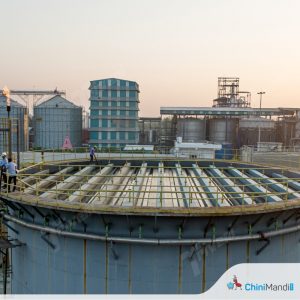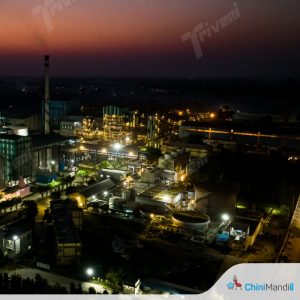The sugar industry body, The Indian Sugar and Bio-Energy Manufacturers Association (ISMA), is urging the government to permit sugar exports, as it will boost the financial liquidity of sugar mills and enable timely payments to cane farmers. In an exclusive interview with ChiniMandi, Tarun Sawhney, Vice Chairman & Managing Director at Triveni Engineering and Industries Ltd., stated that exporting sugar remains more profitable for India than selling it in the domestic market, even at current price differences. He provided insights into several key aspects shaping the company’s strategic direction and industry outlook. Addressing expectations for the ethanol policy and feedstock mix in the upcoming year, Sawhney expressed optimism about a more robust ethanol policy supported by increased government backing. He also discussed the potential impact of MSP increases on the industry, emphasizing the necessity of aligning Minimum Selling Price (MSP) of sugar with Fair and Remunerative Price (FRP) of sugarcane to enhance sustainability and profitability. Furthermore, he outlined Triveni’s proactive measures in sugarcane varietal substitution to combat red rot disease, projecting positive outcomes for future sugar seasons. Sawhney also elaborated on the recent credit rating upgrade by ICRA to AA+ (Stable), highlighting Triveni’s enhanced growth prospects and financial strategies.
Q. What are the expectations for ethanol policy and feedstock mix for the year?
Ans: Overall, we foresee a more aggressive ethanol policy and increased Government support to the industry in the year ahead. While in FY 24, the industry witnessed volatility in both availability and prices of feedstocks for ethanol production, we are hopeful that the Government will take steps to resolve these issues in FY 25 as it remains committed to the Ethanol Blended Petrol (EBP) targets of 20% by 2025-26. We are expecting some positive news for the next tender, such as clarity on quantums of sugarcane-based feedstocks for ethanol production, improved availability of various grain-based feedstocks, ethanol pricing updates, etc. which are likely to have an impact on our distilleries.
As the nation aims for higher ethanol production targets, we expect prices for ethanol produced from both grain as well as for sugarcane-based feedstocks, to be revised upwards for the next Ethanol Supply Year (ESY), especially in the light of suppressed profitability over the last 3-4 quarters which has affected both ethanol volumes and setting up of new distillation capacities.
While sugarcane-based feedstocks have historically been the mainstay of the EBP programme, as the percentage of ethanol blending and hence ethanol requirements increase progressively, contribution of grain-based feedstocks is expected to rise. We, at Triveni, have invested in multi-feed distilleries providing us flexibility to switch between grain and sugarcane-based feedstocks to optimize production and profitability.
Q. What are your thoughts on increasing the MSP? How will it benefit the industry?
Ans: An increase in the Minimum Selling Price (MSP) for sugar is vital for the sustainability of the industry. The MSP has remained unchanged since 2019, while input costs, particularly the Fair and Remunerative Price (FRP) of sugarcane, have risen significantly, now standing at ₹340 per quintal. This discrepancy places a substantial burden on the industry, diminishing profitability and hindering the ability to pay farmers.
Given the rising sugar consumption and higher domestic production projections, aligning the MSP with the FRP is imperative. This adjustment will stabilize the industry, safeguard farmers’ interests, and ensure a steady sugar supply, ultimately benefiting consumers.
Q. What is your outlook on the ethanol industry?
Ans: It is great to see how the Government and industry are working towards achieving a 20% ethanol blending target by 2025-26. The industry has already achieved a blending rate of 15% in May 2024 and remains on track to achieve the above milestones. The availability of E20 has also increased to 12,000 outlets in under a year. Taking a step ahead, the Government has rolled out ETHANOL100 at 183 Indian Oil locations. These efforts signify substantial progress towards achieving the 20% ethanol blending target by 2025-26, reflecting a positive outlook for the industry’s growth and sustainability.
We are aligned with the Government’s vision, and our long-term strategy at Triveni Engineering & Industries Ltd is to grow the Alcohol business by being an active partner in India’s Ethanol Blended Petrol (EBP) programme and self-reliance journey. We recently commissioned a 200 KLPD multi-feed distillery at our sugar unit at Rani Nangal, which has increased our aggregate distillation capacity to 860 KLPD.
Q. What is your outlook on the sugar realisation and exports?
Ans: Sugar realisations remain healthy with current realisations around ₹ 3,950 per quintal for refined sugar and ₹ 3,900 for sulphitation sugar. Despite the large quotas that have been released over the last couple of months by the Department of Food and Public Distribution (DFPD), the sugar realisations have remained reasonably buoyant, and we are very confident that this is an excellent sign for the times to come.
Looking at the industry’s domestic scenario, there have been increases in the recent past in the Fair and Remunerative Price (FRP) and State Advised Price (SAP) as anticipated. The sugar production estimates for SS 2023-24 suggest that we are looking at an higher sugar inventories at the end of this sugar year at ~9 million tonnes. Given this expectation, ISMA has written to the Government requesting an export of 2 million metric tonnes, which we hope is under consideration.
On the export front, even with record sugar production in Brazil and Thailand, export prices remain strong. If India does export a small quantity of 1-2 million tonnes—it will not have a very large impact on the international market. Exporting sugar remains more profitable for India than selling it in the domestic market, even at current price differences.
Q. Your efforts in sugarcane varietal substitution to combat red rot disease show a proactive approach. How do you foresee these efforts impacting your future sugar seasons and overall production?
Ans: The sugarcane development teams have implemented multi-pronged strategies to contain the damage by uprooting the diseased crop, limiting the spread, and carrying out a comprehensive varietal substitution programme to reduce the proportion of the vulnerable Co238 variety especially in the low-lying/ water-logging prone areas. The yield was substituted by high sucrose and high yielding varieties, of which we have substantial and adequate quantum of seed that we have found during the planting season.
Two years back, most of our cane area was under the Co238 variety. We expect to reach optimal levels within two years, which should augur well for our future sugar seasons and overall production.
Q. With the upgraded long-term credit rating to AA+ (Stable) by ICRA, how does Triveni Engineering plan to leverage this improved rating to enhance its growth prospects and financial strategies?
Ans: The rating upgrade is a recognition of our cost-efficiencies, healthy cash flows and fiscal discipline highlighting our robust financial performance and strong creditworthiness. The upgrade reaffirms our position as one of the leaders in the industry and underscores our dedication to delivering value to our stakeholders.
Q. Can you elaborate on the impressive growth seen in the Power Transmission business? What factors contributed to its success?
Ans: The Power Transmission business has registered a record turnover and profitability this year. It has seen a 30 percent increase in the turnover and a 40 percent increase in segment profits, as both the product and the aftermarket segment witnessed buoyancy. PBIT surged 40.1% to ₹ 107.1 cr, with margins improving nearly 275 basis points to 36.7% y-o-y.
A strong aftermarket share has been sustained, which has helped underpin overall profitability. Order bookings for FY 24 shot up 42.3% to ₹375 crore, while the closing order book expanded more than 10% over the previous financial year. There was excellent demand for high-technology products—comprising compressor gearboxes, high-power small hydro turbine applications, and high-power API gearboxes. The outstanding order book as of March 31st was ₹287 crore, including nearly ₹90 crore of long-duration orders.

This year, there was extensive international customer outreach and continued investments in R&D and infrastructure to grow our market share. We are planning to capitalize on global trends and opportunities in the power transmission landscape. Along with significant movement in our Defence segment, the Power Transmission business is on a sustained growth path.
Q. Triveni Engineering has a strong focus on innovation and investment in R&D, especially in the Power Transmission business. Can you talk about some of the new milestones and international outreach efforts achieved this year?
Ans: The business is currently executing a capex program to double the capacity of the Gears business from ₹250 crore to over ₹500 crore, excluding defence production. Investments are focused on a new manufacturing bay and equipment for gearboxes for both power transmission and defence products. This expansion includes a large, dedicated multimodal manufacturing, assembly, and testing facility for defence products in Mysuru.
Furthermore, we are exercising our strong relationships with multinational companies that are present in India and have operations internationally and leveraging them to grow in the above markets. The potential to grow is immense in Western Europe and the United States, where most OEM customers are based.

In addition, the overall economic growth, the market share gains are likely to be major drivers of growth for new products within the power transmission portfolio. Power Transmission business is looking at enhancing and adding value to all our customers by reduction in life cycle costs. There are several research and development initiatives underway to ensure that this offers sustained benefits to our customers, both domestically and internationally, and it benchmarks ourselves to the best standards globally.
In the Defence segment, the business expects increased order booking from the key segments of gas turbines packaging, propulsion gearboxes, propulsion shafting and special application pumps.
Q. Triveni Engineering is focusing on market share gains in Western Europe and the United States. What are some of the unique opportunities you foresee in these regions?
Ans: We’re utilizing our strong relationships with multinational companies in India with global operations to expand into Western Europe and the United States. The opportunity to grow in these markets is tremendous, on account of high concentration of OEM customers. Moreover, economic growth and market share gains are expected to drive growth for new products in our power transmission portfolio.
Q. The defence segment is a critical area for Triveni Engineering. How does the company plan to continue meeting and exceeding global standards in this highly competitive sector?
Ans: In the Defence segment, the business expects increased order booking from the key segments of gas turbines packaging, propulsion gearboxes, propulsion shafting and special application pumps. We aim to secure favourable position with upcoming tenders across a significant number of opportunities.













We need very strong policies for atleast every five years,with reliable few changes in every three months . Export of sugar is highly essential from minimum five million tons , onwards and is possible. Ethanol blending must be E 30 upto 2027 or earlier. The sugar price must be Rs. 45 per kg at present and will be reasonable. Farmers must get FRP of Rs. 400 per quintal of sugar cane. Production of double co-generation than present in sugar units for overall progress. There is a need to make compulsion to every sugar unit to make available sufficient sugar cane for crushing of it and sugar complexes must run minimum 250 days and more, as per climatic conditions. All sugar units must run in profit every year, very strictly. Indian sugar industry is also a back bone of our progress. Indian sugar industry must be a Global Classical for overall progress of many poor countries. Many advantages. Dr. Patil A.S.